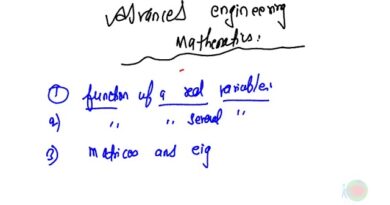Advance Engineering Maths: Function of real Variables
Advance Engineering Maths: Function of real Variables
Contents [hide]
- 1 Functions of Real Variables – Advanced Engineering Mathematics
- 2 1. Definition of a Function of a Real Variable
- 3 2. Types of Functions
- 4 3. Important Properties of Functions
- 5 (i) Domain and Range
- 6 (ii) Limit of a Function
- 7 (iii) Continuity
- 8 (iv) Differentiability
- 9 (v) Mean Value Theorem (MVT)
- 10 4. Applications in Engineering Mathematics
- 11 5. Summary Table of Key Formulas
- 12 Conclusion
- 13 Advance Engineering Maths: Function of real Variables
- 14 Dennis-G.-Zill-Advanced-Engineering-Mathematics- …
- 15 Advanced Engineering Mathematics
Functions of Real Variables – Advanced Engineering Mathematics
In Advanced Engineering Mathematics, the study of functions of real variables is fundamental. It deals with real-valued functions, their properties, limits, continuity, and differentiability.
1. Definition of a Function of a Real Variable
A real function is a rule that assigns a unique real number f(x)f(x) to each real number xx in its domain.
Mathematical Notation:
f:D→R,x↦f(x)f: D \to \mathbb{R}, \quad x \mapsto f(x)
where DD is the domain of f(x)f(x), and f(x)f(x) is the range.
Example:
If f(x)=x2f(x) = x^2, then for x=2x = 2, we get f(2)=4f(2) = 4.
2. Types of Functions
Functions of a real variable can be classified into:
Algebraic Functions – Polynomial, rational, root functions
Trigonometric Functions – sinx,cosx,tanx\sin x, \cos x, \tan x, etc.
Exponential and Logarithmic Functions – ex,lnxe^x, \ln x
Piecewise Functions – Defined in different intervals
Even & Odd Functions –
- Even: f(−x)=f(x)f(-x) = f(x) (e.g., x2x^2)
- Odd: f(−x)=−f(x)f(-x) = -f(x) (e.g., x3x^3)
3. Important Properties of Functions
(i) Domain and Range
- Domain: Set of all values for which f(x)f(x) is defined.
- Range: Set of all possible values of f(x)f(x).
Example:
For f(x)=xf(x) = \sqrt{x},
- Domain: x≥0x \geq 0 (since square root of a negative number is not real).
- Range: y≥0y \geq 0.
(ii) Limit of a Function
The limit of f(x)f(x) as x→ax \to a is written as:
limx→af(x)=L\lim_{x \to a} f(x) = L
Example:
limx→2(3x+5)=3(2)+5=11\lim_{x \to 2} (3x + 5) = 3(2) + 5 = 11
(iii) Continuity
A function is continuous at x=ax = a if:
limx→a−f(x)=limx→a+f(x)\lim_{x \to a^-} f(x) = \lim_{x \to a^+} f(x)
f(a)f(a) is defined
limx→af(x)=f(a)\lim_{x \to a} f(x) = f(a)
Example:
f(x)=x2f(x) = x^2 is continuous everywhere, but f(x)=1xf(x) = \frac{1}{x} is not continuous at x=0x = 0 (because it is undefined).
(iv) Differentiability
A function f(x)f(x) is differentiable at x=ax = a if the derivative exists:
f′(x)=limh→0f(x+h)−f(x)hf'(x) = \lim_{h \to 0} \frac{f(x+h) – f(x)}{h}
Example:
For f(x)=x2f(x) = x^2,
f′(x)=2xf'(x) = 2x
f(x)f(x) is differentiable everywhere.
(v) Mean Value Theorem (MVT)
If f(x)f(x) is continuous on [a,b][a, b] and differentiable on (a,b)(a, b), then there exists a point cc such that:
f′(c)=f(b)−f(a)b−af'(c) = \frac{f(b) – f(a)}{b – a}
Example:
For f(x)=x2f(x) = x^2 on [1,3][1,3],
f′(c)=9−13−1=4⇒2c=4⇒c=2f'(c) = \frac{9 – 1}{3 – 1} = 4 \Rightarrow 2c = 4 \Rightarrow c = 2
4. Applications in Engineering Mathematics
Signal Processing – Continuous functions in Fourier Analysis
Control Systems – Stability of real functions in system response
Thermodynamics – Behavior of state functions like entropy
Fluid Mechanics – Velocity profile functions
5. Summary Table of Key Formulas
| Concept | Formula |
|---|---|
| Limit | limx→af(x)=L\lim_{x \to a} f(x) = L |
| Continuity | limx→af(x)=f(a)\lim_{x \to a} f(x) = f(a) |
| Derivative | f′(x)=limh→0f(x+h)−f(x)hf'(x) = \lim_{h \to 0} \frac{f(x+h) – f(x)}{h} |
| MVT | f′(c)=f(b)−f(a)b−af'(c) = \frac{f(b) – f(a)}{b – a} |
Conclusion
Functions of real variables form the foundation of Advanced Engineering Mathematics, and their concepts are widely applied in engineering fields. Understanding their properties helps in solving real-world problems.
Would you like practice problems or detailed proofs for any theorem?

